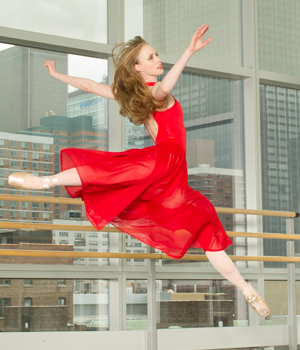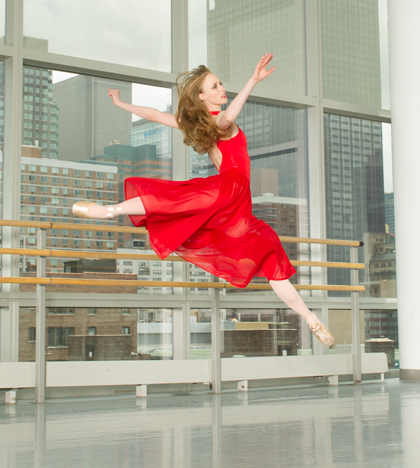All About Allegro
 Most people would think that children naturally know how to jump. As a seasoned dance teacher, I beg to differ. I see many young dancers “hopping” or “bouncing” but very few that can actually jump. By my definition, dancers truly jumps when they use their legs to push their body off the floor, reach a distinct elevation, and make a slight pause in the air before landing.
Most people would think that children naturally know how to jump. As a seasoned dance teacher, I beg to differ. I see many young dancers “hopping” or “bouncing” but very few that can actually jump. By my definition, dancers truly jumps when they use their legs to push their body off the floor, reach a distinct elevation, and make a slight pause in the air before landing.
So how do we teach a skill that seems to be so natural but proves to be so difficult?
Here are some tips and exercises I use with my students that have helped improve their jumping.
Primary Level
This age division thrives on imagery and imitation so I use a lot of make believe to get my students to jump. Musicality is also key so make sure your music matches the energy and emphasis you want your students to master in the jumps.
- Rocket ships-Have students start in a crouched position. Teacher does a countdown “3,2,1, BLASTOFF!!” On “BLASTOFF” the students push off the floor as high as they can and reach for the sky like a rocket ship blasting into outer space.
- Carousel-Have students do a pony canter in a circle around the room.
- Spinning Skip-Start skipping on a diagonal and then add skipping en tournon (turning).
- Hiccups– Have students pretend they have a really bad case of hiccups, preferably “silent” hiccups. When they jump in the air, they have to stay up long enough for the hiccup to pass before they can land. This imagery works great for introducing chasses and glissades.
When I introduce “real” dance jumps (sautés, echappes, glissades, etc), I make sure each jump takes 4 counts.
- “1” plie
- “2” jump
- “3” plie
- “4” straighten legs
Intermediate Level
I find this age division to be obsessed with comparison and fairness so I use it to my advantage when I introduce new jumps. I have pictures downloaded on my phone of professional dancers doing the leaps and jumps that I teach at this level. After explaining the technique of a jump and having them practice awhile on their own, I show my students these pictures. It seems to really click in my students mind when they see what the step is supposed to look like.
Sitting jumps. Students begin sitting down with their feet, in 1st position, against a wall and hands on their hips. Without losing control of the upper body, have students push off the wall as far as they can. To really engage their legs, have students compete to see who can push off the farthest. Once they have practiced this a couple of time, have students stand up and use the same muscles to push off the floor in a simple allegro combination.
Jumping Down (quadricep engagers) and Jumping Up (calf engagers). Create combinations that engage different muscle groups in the legs so dancers can work each group in their class.
Example: pas de chat, changement, pas de chat, changement (all Jumping Up steps), 3 assembles (all Jumping Down steps), hold 5th position and straighten knees.
At this level, students start to learn more complicated jumps and old habits rear their ugly heads My students continually try to use their arms and shoulders for momentum to help their jump which obviously does not work. When this happens, I tell my students to try to get their chest bone (what I call the top of the sternum) higher than their shoulders. Immediately, students are engaging their shoulders and back so that they can move their arms without losing control of their upper body.
Advanced Level
I find the majority of this age division, especially the girls, to be lazy when it comes to jumps. Whether they are tired, injured, or who knows what else, it seems to me that the majority of the allegro portion of my advanced classes get sat out. Whenever this seems to happen I give my “Jumping is Good for You” speech.
Basically I tell them that jumping is GOOD for you! It is a weight bearing exercise that triggers your brain to build bone and muscle mass. Jumps are exactly what every dancer needs to improve their technique, their strength, and prevent future injury. When my advanced dancers learned this, there was a huge shift in the amount of participation in my allegro combinations.
Challenge your advanced dancers with space and music. Have them perform combinations that travel forward, backward, diagonal, diagonally backward, zig zag, in a circle, and more. Or start with a combination and then speed it up to have them use their “jumping up” muscles then slow it down for their “jumping down” muscles.
I love to see the shock of surprise and amazement on a dancer’s face when they first experience the weightlessness and a pause in the air that comes from a real jump. Their sense of “Wow, I can do it” is contagious and inspiring. I love those moments because both myself and the student get to go home from the studio feeling accomplished and changed and that is what teaching dance is ALL about!
Until next time, teach, inspire, and grow!



